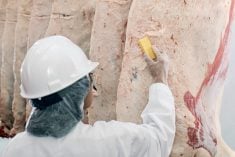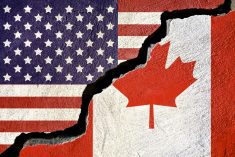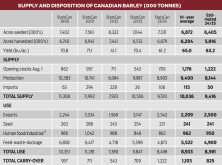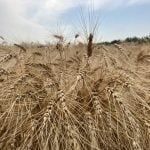I have reported on the livestock industry in several countries for just over 40 years. I can say with certainty that weather extremes in North America surpass those of any other continent except Australia. The latter appears to have cycles of devastating drought followed by flooding. North America gets both extremes and a lot more as well.
This year is only three months old but it has been tough for U.S cattle producers. Carcass weights plunged for several weeks after a brutal winter storm swept across much of cattle feeding country in early January. The hardest hit areas saw weigh-ups at feedlots reduced by 100 pounds or more. Carcass weights began to increase again in mid-February after the weather abated. But some cattle feeders since then have held back cattle to allow them to regain the weight they lost before selling them.
However, there is a consequence to this. The economics of adding weight favours the producer, with average and marginal gain costs below the selling price of cattle, says Andrew Gottschalk, HedgersEdge.com. But this action understates available supplies near term while delaying some sales by several weeks. The latter will add to second-quarter front-end supplies, he says.
Meanwhile, the Texas Panhandle and western Oklahoma experienced widespread devastation after several huge wildfires burned more than one million acres of farmland and ranchland the first week of March. Wildfires began because of abnormally hot and dry conditions. The largest fire quickly became the biggest in state history. Multiple evacuations were ordered and Governor Greg Abbott declared a disaster for 60 counties as emergency crews attempted to contain the fires. The fire, in just four days, killed tens of thousands of cattle, said Texas agriculture commissioner Sid Miller. But as tragic as this was for cattle producers, this represented only a tiny percentage of Texas’s January 1 cattle herd of 12 million head and beef cow population of over 4.1 million head.
Read Also

The Canadian Cattle Association’s international advocacy efforts
Global ag policies affect Canadian food policy, so the Canadian Cattle Association participates in international and domestic forums
A dusting of snow covered a desolate landscape of scorched prairie, dead cattle and burned-out homes in the Texas Panhandle in late February, according to an Associated Press story. This gave firefighters brief relief in their desperate efforts to corral a blaze that grew into the largest in state history. The Smokehouse Creek fire grew to more than one million acres. The previous largest fire was the 907,245- acre East Amarillo Complex fire in March 2006. The Texas Panhandle is home to the most concentrated cattle feeding region in the U.S. and the world. However, feedlots appear to have avoided damage or cattle deaths. Cattle were primarily affected by smoke and feedlots were working with veterinarians to ensure that affected cattle returned to good health.
The cruel irony is that the conditions that set off the fires came after the federal Drought Monitor revealed that only 15 per cent of the nation’s cattle herd was in a drought area, versus 53 per cent a year ago, for the period ending February 20. This holds the key to the level of cow slaughter and heifer retention for this year, says Gottschalk. There are similarities to the 2014-16 period, which triggered herd expansion. Given an improved grazing outlook, he expects heifer retention to begin this year. But this change from last year will further restrict the available feeder cattle and calf supply for placement into feedyards. The competition for this limited supply is likely to have feeder cattle and calf prices challenge the upper level of the historical trends of these prices versus fed cattle prices, he says.
















